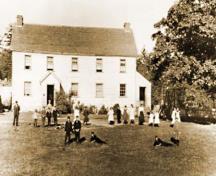CRAIGFLOWER SCHOOL
The Oldest School Building in Western Canada
Craigflower School in the City of Victoria, British Columbia, opened its doors in March of 1855 to twenty-six students. The first teacher was Charles Clark, who lived in the accommodation upstairs with his family and a few boarders from outlying areas.

This little school, alongside the Gorge waterway, is featured in my forthcoming novel – DESTINY (book Two in the McBride Chronicles series). It was one of several established by Vancouver Island’s Colonial administration and was built by Gideon Halcro and his workers. Halcro worked on orders given him by Kenneth McKenzie who had established nearby Craigflower Farm. At that time, a school was desperately needed for the children of the farm employees and the many settlers arriving in Victoria. It was initially called Maple Point School.
The lumber and the bricks used in the foundation of the school were produced at nearby Craigflower Farm which was one of the farms established for the Puget Sound Agricultural Company, a subsidiary of the Hudson’s Bay Company. The glass, hardware and larger bricks used in the school’s construction were imported from England. The entire project was completed on February 23rd, 1855, at a total cost of $4,300.
The building of Craigflower Schoolhouse had been quick, a mere six months, considering Halcro had earlier been criticized by Fort Victoria’s Dr. Helmcken for being slow while building his house in town. At that time, he had stated:
Halcro could do carpentering, plastering and everything connected with a house, so I got him to go on with the work, but oh, the grumbling . . .
And oh, how slowly – for I wanted the house to be finished by the springtime.
 Nonetheless, the Schoolhouse at Craigflower built two years later was a fine building, erected to specifications in record time. The two-story building had one schoolroom and six other rooms for a teacher and student boarders upstairs.
Nonetheless, the Schoolhouse at Craigflower built two years later was a fine building, erected to specifications in record time. The two-story building had one schoolroom and six other rooms for a teacher and student boarders upstairs.
The same week the school opened, the steamer Major Tompkins was wrecked off Macaulay Point. The ship’s bell was retrieved and used for the school and was hung in the schoolyard to announce the opening of school every morning, and to bring in the children from recess break.
At the time, there were twenty other buildings on the site including a sawmill, a flour mill, a blacksmith’s shop, a slaughterhouse, a general store, and a brick kiln. A total of seventy-six people lived at Craigflower Farm as employees of the McKenzie family. The McKenzies lived there until 1866 at which time they moved to their own sheep farm in the Lake Hill area.
The first Craigflower bridge was built in the winter of 1866, and this linked the little school to the Craigflower settlement. Gideon Halcro’s building was used as a schoolhouse (and as a focal point for numerous social events) until 1911, when a new larger Craigflower School was built across the road. A third building (the present-day one) was built in 1964.
The old original schoolhouse remained vacant until 1931 when it was converted into a museum and run by the Native Sons and Daughters of British Columbia until 1975. During that period (in 1967) both the schoolhouse and nearby Craigflower Farm were declared National Historic Sites.
In 1975 the Province’s Historic Parks and Sites branch acquired the property and restored it, eventually re-opening it once again as a museum. The old schoolhouse, the oldest still standing in the west, was briefly under the care of The Land Conservancy of British Columbia. Today it is the home of the Heritage Foundation and is open to the public for special presentations during the summer.
In my forthcoming novel DESTINY, (Book Two in the McBride Chronicles 4-book series), Jane and Gideon’s daughter, Sarah, attends this little one-room schoolhouse in the 1870s, travelling down the Gorge Arm by watercraft from her prestigious home, Providence. Being a rebellious child, she often finds herself in trouble during those school years!
Hope you enjoy Book Two to be released later this summer!
